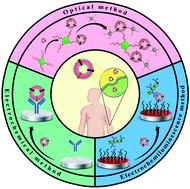Biomedical analysis of exosomes using biosensing methods: recent progress
Abstract
Exosomes are membrane-bound extracellular vesicles (EVs) that are produced in the endosomal compartments of most eukaryotic cells; they play important roles in intercellular communication in diverse cellular processes and transmit different types of biomolecules. Endocytic pathways release exosomes, which have diameters ranging from 50 to 200 nm. The unique functions of exosomes have been introduced as cancer bio-markers due to the cargo (protein, DNA and RNA) of external exosomes (tetraspanin) and internal exosomes (syntenin). The early detection of cancer by exosomes can be an excellent method for the treatment of cancer. Although detection methods based on exosomes are important, they require extensive sample purification, have high false-positive rates, and encounter labeling difficulties due to the small size of exosomes. Here, we have reviewed three major types of biosensors, namely, electrochemical biosensors, optical biosensors and electrochemiluminescence biosensors for the detection of exosomes released from breast, ovarian, pancreatic, lung, and cervical cancer cells. In addition, the importance of nanomaterials and their applications in the biomedical analysis of exosomes are discussed. Although exosomes can be used to identify various types of external and internal biomarkers by conjugating with recognition elements, most designed biosensors are based on CD9 and CD63. Therefore, the development of novel biosensors for the selective and sensitive detection of exosomes is a current challenge. We hope that this review will serve as a beneficial study for improving exosome detection in clinical samples.



 Please wait while we load your content...
Please wait while we load your content...